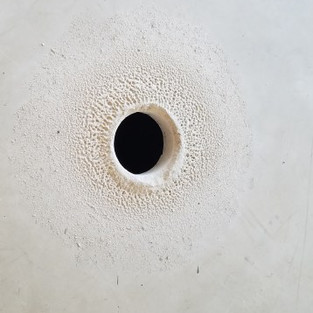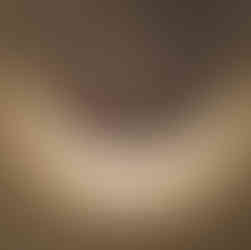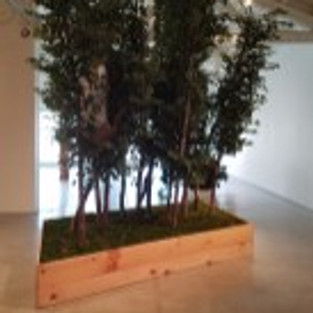
Dennis Oppenheim. Where the Sidewalk Ends. Moran Bondaroff. Photo Credit Jackie Bell Johnson
Where the Sidewalk Ends, a Group Exhibition at Moran Bondaroff
By Jacqueline Bell Johnson
Through May 20th
Moran Bondaroff’s current exhibition Where the Sidewalk Ends sets up the conversation of what “natural” looks like without the context of nature, of what nature is to those who have never seen it beyond encounters in the urban landscape. This show is not an environmental lecture. It is a playful exercise in building one’s own world, an ecosystem of concrete, fake leaves, and imitated beauty.
The show features the work of four artists: Terence Koh, Dennis Oppenheim, Virginia Overton, and Nick van Woert, with a collection of works that replicate the materials and processes that create modern life: developed land. The artists often take an archaeological approach toward their usage, as if by creating art with these objects they are hypothesizing what the original intended usage was.
Virginia Overton’s sculptures are a three-dimensional collage of street-side discarded objects. Sensitive to the pillar as an artificial stand-in for a tree, her works play with their protective functions and human expectations. Using concrete molds as a substitute they are placed overshadowing the body of the viewer. Untitled (brown piece) has a wooden chair placed atop the cardboard tube, its rigid legs, not unlike branches. Untitled (ecoform aerator) is more comforting, with its quiet rumble and emitted light.
Her largest work, and the first piece seen when walking through the gallery doors is Overton’s Untitled (log with bamboo). This sculpture is a tree made from trees, using a pine trunk and bamboo branches. The placement of the branches makes it difficult to enjoy the object as a tree, they are too spacious, too low, preventing the viewer from getting too close, or utilizing the branches as a canopy. Lights hang from the trunk converting this object into an appliance, referencing structure more than vegetation.
Following the lead of industrial progress, the late Dennis Oppenheim takes building/landscaping into his own hands with his sculpture Tree House Structure for Poisoned Soil #1, #2, #3. Made in 1978 the work seems timeless: a distant-future architectural model where human alteration of terrain is rebalanced as symbiotic instead of parasitic.
Nick van Woert’s pieces all consist of a stylish black and dark brown palette, with a curious texture that appears to crystalize or grow. The repulsion comes about when reading the list of materials, including coal slag and tar paper. That repulsion, however is the viewer’s. Van Woert’s use of such materials is matter-of-fact. The three wall pieces are an expose of sorts of what can be found on exterior walls, bringing them inside to be contemplated more thoroughly.
Terence Koh’s hole is a smart addition to the show. A hole made into the concrete floor of the gallery gives the viewer an opportunity to look below the floor. What is found is nothing, the space is completely dark with no visibility. The artist himself only claims the negative space as his materials for the piece, which makes the viewer’s interest in the freshly disturbed concrete their own. The need to grab hold of something with one’s eyes is left unsatisfied, and so the viewer clings to the dust and emerging pattern in the damaged floor.
Where The Sidewalk Ends is on view at Moran Bondaroff through May 20th.
#losangeles #california #losangelesartist #art #VirginiaOverton #onlineartmagazine #MoranBondaroff #losangelesart #contemporaryart #southerncalifornia #multimedia #DennisOppenheim #artgallery #gallery #multimediaartist #artandcake #artexhibition #ArtandCakeLA #fineart #artist #mixedmedia #artsmagazine #arts #artreview #sculpture #artexhibit #ArtandCulture #exhibition #WheretheSidewalkEnds #TerenceKoh #exhibit #JacquelineBellJohnson #NickvanWoert






























































